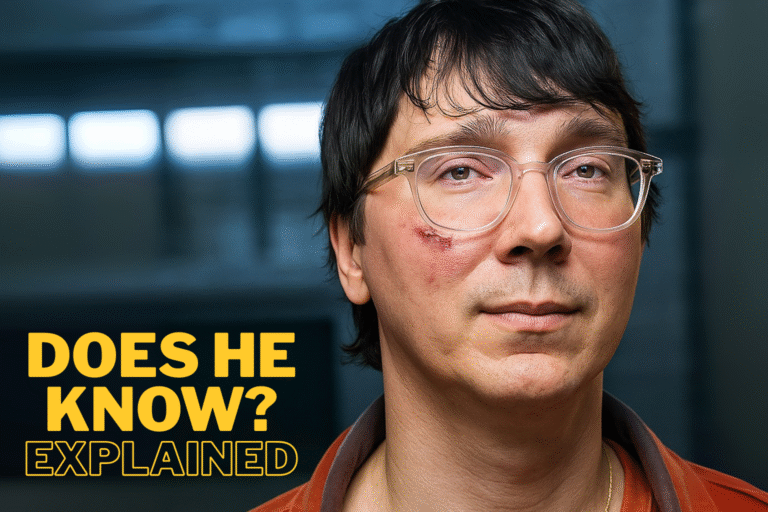
You’ve probably seen it in TikTok comments or Twitter replies: SYBAU. Maybe you thought it was a foreign word, a brand name, or some kind of code. You’re not alone – millions of people have been confused by these five letters that seem to appear everywhere online.
SYBAU means “Shut Your Bitch Ass Up.” It’s an acronym that turns a harsh insult into internet slang. This phrase has exploded across social media, becoming one of 2025’s biggest meme trends. Young people use it to tell others to be quiet, usually in a joking or sarcastic way.
But there’s more to this story than just another rude acronym. SYBAU represents how internet culture transforms language, how memes spread globally, and why certain phrases capture the attention of millions. Lessons in Meme Culture explains everything: where SYBAU came from, why it went viral, and what it means for online communication today.
Everyone’s Using SYBAU But Most Don’t Know What It Means. What Does it Actually Mean?

SYBAU stands for “Shut Your B**ch As* Up.” People pronounce it as “sigh-bow” when saying it out loud. The phrase is aggressive – it’s a rude way to tell someone to stop talking or be quiet.
The term works as internet shorthand. Instead of typing out the full insult, users just write “SYBAU.” This makes it feel less harsh while keeping the same meaning. It’s similar to how people write “WTF” instead of the full phrase.
Young internet users, especially on TikTok and Twitter, adopted SYBAU as a way to express frustration. They use it when someone annoys them, shares spoilers, or says something they disagree with. The acronym gives them a quick way to push back without writing a long response.
This Acronym Actually Started in 2003, Not on TikTok Like Everyone Thinks
Many people think SYBAU started on TikTok in 2024, but the truth goes back much further. The earliest record appears on Urban Dictionary in November 2003. A user named “gh0ti a.k.a markie” first defined it as “shut your bitch ass up.”
For twenty years, SYBAU lived quietly in internet corners. Gamers used it in chat rooms. Teenagers wrote it in text messages. It appeared occasionally on forums and social media, but never caught widespread attention.
The phrase stayed dormant until late 2024. That’s when TikTok users discovered it during a trend of using excessive acronyms. Creators started combining multiple slang terms like TS (this shit), PMO (piss me off), and ICL (I can’t lie) in their videos. SYBAU fit perfectly into this acronym overload trend.
This context matters because SYBAU didn’t emerge in isolation. It rode the wave of TikTok’s love for abbreviated slang. Users would create videos packed with acronyms, often satirizing how confusing internet language had become. SYBAU became part of this larger conversation about online communication.
Two Specific TikTok Videos Turned SYBAU Into a Massive Meme Phenomenon
The viral breakthrough happened in early 2025 through specific TikTok videos that captured millions of views.
On February 8, 2025, TikTok creator @swaggsolos (Hakeem) posted a video that changed everything. He casually used SYBAU while talking about everyday annoyances. The video exploded, reaching over 2 million views in three weeks. This showed the internet that SYBAU had serious viral potential.
@swaggsolos
Three weeks later, @onmybehalf created a parody video that pushed SYBAU even further. Posted on February 25, 2025, this clip deliberately misdefined SYBAU as “so you’re beautiful and unique.” The creator used cheerful music and colorful visuals to present this fake positive meaning. The obvious contradiction made people laugh, and the video gained 1.6 million views in just three days.
@onmybehalf
These two videos created a perfect storm. The first showed SYBAU’s natural appeal, while the second demonstrated its meme potential through humor and contradiction. Together, they introduced the acronym to millions of new users.
The spread didn’t stop at TikTok. Twitter users began incorporating SYBAU into their tweets, especially when responding to annoying posts or spoilers. Instagram meme pages picked it up and created shareable content. Within months, SYBAU appeared across every major social platform.
Why Millions of Frustrated Users Choose SYBAU Over Regular Boring Insults
SYBAU succeeded because it solves a common online problem: how to express frustration quickly and memorably.
Social media moves fast. Users don’t have time to write lengthy responses to every annoying post or comment. SYBAU gives them a swift way to express irritation. It’s more interesting than just writing “shut up” and less effort than crafting a detailed comeback.

The acronym also taps into shared online experiences. Everyone encounters spoilers, trolls, and annoying posts. SYBAU became a collective response – a way for users to show solidarity against digital annoyances. When someone posted Love Island spoilers on Twitter, fans would respond with “SYBAU” to express their shared frustration.
The mystery factor helped too. Many people admitted they had no idea what SYBAU meant when they first saw it. One popular tweet said, “I thought sybau was a Japanese word up until two days ago.” This confusion created engagement – people had to ask questions, search for answers, and share their discoveries.
SYBAU also benefits from being simultaneously harsh and playful. The underlying message is aggressive, but the acronym format makes it feel less personal. Users can express strong emotions while maintaining some distance through the abbreviated form.
Creative Users Transformed SYBAU Into Countless Visual Memes and Reaction Images

Once SYBAU gained traction, internet culture transformed it into various meme formats.
The most famous evolution became the “SYBAU Guy” meme. This reaction image features TikTok personality Lazer Dim 700, a tall rapper, holding up his hands. Large text reading “SYBAU” appears over the photo, along with a broken heart emoji 💔 and a dead rose emoji 🥀.
The image creates a perfect contrast – Lazer Dim’s serious expression combined with the cute emojis and harsh text. This combination became irresistible to meme creators. The image spread across TikTok as a comment sticker and reaction image on Twitter.
Creators began making their own versions. They replaced Lazer Dim with anime characters, cartoon mascots, and video game sprites while keeping the “SYBAU” text and emoji combination. The format proved flexible enough to work with almost any character or image.
Other remix formats emerged too. People created dance videos with SYBAU text overlays. Others made compilation videos listing internet acronyms and their meanings, always including SYBAU for shock value. Some users turned SYBAU into song lyrics or incorporated it into existing memes.
The remixing tools remained simple – basic text editors, video caption features, and drawing apps. This accessibility allowed fans to create new SYBAU content quickly and continuously. The meme became part of TikTok’s creative toolkit, a reusable element that creators could adapt for different purposes.
SYBAU Conquered Online Communities But Never Broke Through to Mainstream Media
SYBAU remained primarily an internet phenomenon. Unlike some memes that cross into mainstream media, SYBAU stayed within online communities. Brands avoided it due to its profane meaning, and traditional media rarely mentioned it.
However, the acronym did penetrate specific online communities deeply. Love Island fans used it regularly to respond to spoilers and unwanted commentary. Gaming communities adopted it for trash talk and reactions. Various fan forums incorporated SYBAU into thread titles and discussions.
Some international users discovered SYBAU through English-language content. Reddit threads appeared where people asked for translations in other languages. Korean TikTok users made explanation videos about American internet slang, including SYBAU. This showed the phrase’s global reach within internet-connected communities.
The “positive definition” joke became a minor cultural phenomenon itself. Multiple creators made videos pretending SYBAU meant “Stay Young, Beautiful And Unique” or similar uplifting phrases. These parodies highlighted how internet culture often reclaims or redefines harsh language.
No major controversies surrounded SYBAU. Most people understood it as typical internet slang – crude but not particularly harmful. It existed in the same category as other abbreviated profanity that’s common online.
Where SYBAU Actually Stands Today Across Different Countries and Social Platforms
Six months after its peak, SYBAU has cooled but not disappeared. Its strongest period ran from February through June 2025. Since then, usage has declined as newer memes captured attention – a normal pattern for internet trends.
TikTok and Twitter remain the primary platforms for SYBAU usage. Instagram meme pages still occasionally post SYBAU content, but less frequently than during the height of its popularity. New users continue discovering it, creating small waves of renewed interest.
Geographically, SYBAU spread primarily through English-speaking internet communities. The United States generated most of the original content, with the UK contributing significantly through Love Island fan discussions. However, the phrase reached users worldwide through platforms like TikTok that have global audiences.
Non-English speaking users encountered SYBAU mainly through viral videos with subtitles or explanation content. Some incorporated it into their own posts while writing primarily in their native languages. This created interesting multilingual social media posts that mixed SYBAU with other languages.
The acronym performed differently across platforms. TikTok hosted the video content – dance trends, explanation videos, and comedy sketches. Twitter became the platform for quick reactions and commentary. Instagram focused on static meme images and reposts. Facebook saw less organic usage, mainly appearing in shared content from other platforms.
Meet the Real Creators and Influencers Who Actually Made SYBAU Go Viral
Several individuals played crucial roles in SYBAU’s rise to prominence.
gh0ti (“markie”) deserves credit as the original documenter, creating the first Urban Dictionary entry in 2003. While this person didn’t invent the phrase, they preserved its definition for future generations.
Hakeem (@swaggsolos) became the breakthrough creator whose February 2025 video demonstrated SYBAU’s viral potential. His natural usage in everyday conversation showed how the acronym could work in normal content.
Gabriel Villa (@onmybehalf) created the parody video that expanded SYBAU’s reach through humor. His fake positive definition became almost as famous as the real meaning.
Lazer Dim 700 didn’t create SYBAU content himself, but his image became the iconic “SYBAU Guy” meme. His serious expression in the photo provided the perfect contrast for the harsh text and cute emojis.
Various meme page administrators and content creators contributed by sharing and remixing SYBAU content. These individuals rarely gained individual recognition but collectively drove the meme’s spread across platforms.
Explanation websites like KnowYourMeme and HerCampus documented SYBAU’s evolution, helping curious users understand its meaning and context. These resources bridged the gap between insider knowledge and mainstream awareness.
Will SYBAU Survive 2026 or Join the Massive Graveyard of Dead Memes
Predicting meme longevity remains difficult, but several factors suggest SYBAU’s future trajectory.
Current trends indicate declining usage. Google search data shows peak interest in mid-2025 followed by gradual decline. Social media mentions have decreased compared to the height of the trend. New acronyms and slang terms compete for attention in the fast-moving internet landscape.
However, SYBAU could experience a comeback. Internet culture often cycles through nostalgic phases where old memes return. Reality TV seasons, gaming tournaments, or other events that generate online drama could revive SYBAU as a go-to response.
The acronym format itself remains popular. New variations might emerge that follow SYBAU’s pattern – taking a common insult or phrase and abbreviating it for internet use. SYBAU proved this formula works, potentially inspiring similar creations.
International communities might adopt SYBAU or create equivalent acronyms in their own languages. The concept of abbreviated frustration responses translates across cultures, even if the specific words don’t.
SYBAU’s legacy will likely be as a representative example of mid-2020s internet culture. It captures how young people communicate online, how memes spread globally, and how language evolves in digital spaces. Future internet historians studying this era will probably reference SYBAU as a typical example of viral slang.
How SYBAU Actually Reveals the Hidden Way Internet Language Constantly Evolves
SYBAU represents more than just another viral acronym. It demonstrates how internet communities create and spread language independently of traditional institutions.
The phrase shows how old internet slang can find new life through different platforms and contexts. SYBAU existed for twenty years before finding its moment on TikTok. This suggests that much of internet culture exists in layers, with older elements waiting for the right conditions to emerge.
The global spread of SYBAU illustrates how English-language internet content influences worldwide digital communication. Non-English speakers encountered and adopted the phrase, incorporating it into their own online expression. This creates a shared vocabulary across different language communities.
SYBAU also highlights the role of visual memes in language spread. The “SYBAU Guy” image became almost as important as the text itself. Visual elements help ideas cross language barriers and create memorable associations.
The trend reveals how internet users balance expression with efficiency. SYBAU lets people communicate strong emotions quickly without lengthy explanations. This efficiency drives much of internet language evolution, as users constantly seek faster ways to express complex ideas.
Key Takeaways
SYBAU means “Shut Your Bitch Ass Up” – a blunt acronym that became major internet slang in 2025. Despite existing since 2003, it found viral success through TikTok creators who demonstrated its meme potential.
Two key videos sparked the trend: @swaggsolos’s natural usage video (2+ million views) and @onmybehalf’s parody “positive definition” video (1.6+ million views). These posts introduced SYBAU to millions of users and established its viral patterns.
Visual memes enhanced the spread: The “SYBAU Guy” reaction image featuring Lazer Dim 700 with broken heart and dead rose emojis became an iconic way to use the phrase. This image format allowed easy sharing and remixing across platforms.
Multiple platforms adopted it: TikTok hosted video content, Twitter became the reaction platform, and Instagram spread meme images. Each platform used SYBAU differently but contributed to its overall popularity.
Global reach with English focus: While primarily used in English-speaking communities, SYBAU reached international audiences through viral videos and explanation content. Non-English speakers incorporated it into multilingual posts.
Current status shows typical meme lifecycle: Peak popularity in early-to-mid 2025 followed by gradual decline as newer trends emerged. SYBAU remains in use but at lower levels than during its viral peak.
Cultural significance beyond the acronym: SYBAU demonstrates how internet communities create language, how visual elements enhance text-based memes, and how global platforms spread cultural phenomena across language barriers.
SYBAU captures a specific moment in internet culture when young users transformed old slang into new viral content. Its story shows how digital communities constantly reinvent communication, creating shared vocabularies that span continents and languages. Whether SYBAU returns to prominence or remains a 2025 time capsule, it represents the creative energy that drives internet culture forward.







